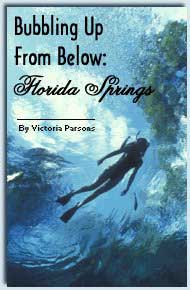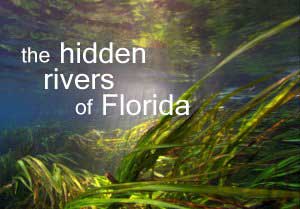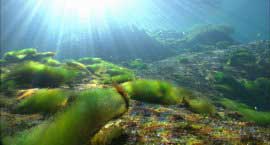|
 Although an accurate world inventory is not available, Florida probably has more springs than anywhere else in the world. Many of those springs, however, are jeopardized by nearby development. Although an accurate world inventory is not available, Florida probably has more springs than anywhere else in the world. Many of those springs, however, are jeopardized by nearby development.
Across the state, both water quality and quantity have declined. In Tampa Bay, where 50 springs or pseudosprings have been documented, less than a half-dozen are still used for recreation or as significant sources of potable water. Perhaps the names of cities and parks that refer to now-defunct springs best tell the tale: Sulphur Springs, Tarpon Springs, Philippe Springs, Eureka Springs and Safety Harbor Spring are all nearly dry or so contaminated they are unsafe for swimming.
Historically, springs have attracted humans since the days when we shared them with mastodons. Hernando De Soto is said to have discovered the Fountain of Youth in Safety Harbor on May 18, 1539. According to an historic marker on the site, De Soto named the springs Espiritu Santo Springs or “Springs of the Holy Spirit."
Each of the five springs was said to cure certain ailments, a claim that drew thousands of visitors to the "Health Giving City" of Safety Harbor. They still flow beneath the Safety Harbor Spa where their mineral-rich waters are used in the spa’s swimming pools and water coolers.
The region’s best known spring may be Sulphur Spring, but it’s likely that more people recognize the distinctive concrete water tower at Bird Street near Interstate 275 in Tampa than the spring itself. The spring’s “miraculous” healing waters attracted visitors from across the nation and developer Josiah T. Richardson built a 1920s Mediterranean-style building that may have been the state’s first shopping mall.
As the story is told, Richardson was nearing completion of the new building when he realized that he would need more water than what was available in the spring that fed a swimming pool adjacent to his booming resort. No ordinary developer, he built a 210-foot poured-in-place concrete water tower with a 45-foot deep foundation to capture water from an unnamed artesian spring.

While the landmark tower at Sulphur Springs is the most well-known remnant of the booming ’20s resort, the same developer also built a classically inspired gazebo around a small spring that spills over into a shallow pool. The gazebo is currently behind locked gates but the City of Tampa hopes to restore and open it soon.
|
Today, little remains of Richardson’s legacy, but the tower still stands and the springs continue to flow. The namesake main spring – actually located near Nebraska Avenue across I-275 from the landmark tower – is surrounded by concrete and closed to recreational uses because of high bacterial counts attributed to stormwater.
Further down the river, small springs serve as nearly silent reminders of the region’s history. Water from Purity Spring creates a small pond and creek that flows softly in a small unnamed park just off Hillsborough Avenue. Originally owned by the Purity Spring Water Company, the City of Tampa purchased the spring when it consolidated water service.
The Water Works Park, located off North Highland Avenue, also is built around an artesian spring that provided nearby homes and businesses with water. Even Lowry Park, most well known for its zoo, features a spring at the north end of the property that feeds a small pond before it flows into the river.
“People in cities don’t necessarily think about springs,” says Tom Johnston, an urban planner with the Tampa Parks Department who was instrumental in the city’s recent purchase of the 13-acre site with the water tower. “A lot of them are still there but most people don’t even stop to wonder where creeks come from.”
Springs Still Important to Ecosystem
Over the years, flow and water quality at Sulphur Springs have declined and recent reports indicate high levels of salt, nitrates and bacteria. The bacteria, in particular, probably comes from nearby sinkholes that are being used for stormwater drainage, according to area residents.
“Some people seem to think the springs are just an annoyance, something that they’d rather not deal with,” says Linda Hope, a long-time community activist in Sulphur Springs. “But the only time they’re really contaminated is right after a good rain – 48 hours later they’re as clear as a bell and perfectly swimmable.”
The City of Tampa replaced the original spring-fed swimming pool with a state-ofthe-art heated and chlorinated pool. “We’ll probably never be able to open the spring for swimming again,” Johnston says.
Its location in a highly urbanized setting makes is very difficult to alleviate contamination from stormwater, adds Sid Flannery, senior environmental scientist for the Southwest Florida Water Management District.
Still, the spring continues to play an important role in Tampa Bay’s ecosystem, contributing much of the freshwater in the lower Hillsborough River during dry season and droughts, he adds. “It’s a fairly constant flow and the run from the spring to the river has a diverse assemblage of invertebrates and fish.”
That’s likely to continue, thanks in part to Friends of the River, a community group formed to force the City of Tampa to stop diverting water from Sulphur Springs to the Hillsborough River reservoir.
“Without the water from Sulphur Springs, the river can have bay water salinity nearly all the way back to the dam during droughts,” notes Phil Compton, a founder of the organization.
A five-year study on river salinity and dissolved oxygen is expected to result in a re-evaluation of minimum flows later this year, but changing weather patterns and the proposed Downstream Augmentation Project make it less likely that the flow from Sulphur Springs will be diverted again.
Compton also is hopeful that water quality will continue to improve on the lower Hillsborough River. “I live on the river so it’s a backyard issue for me,” he says. “And I have to admit, this isn’t a matter of conservation – at this point, it’s restoration. But if you look at great cities around the world, the Thames River through London was once nothing but a sewer and the Hudson River in New York was a cesspool. We’re nowhere near as bad as that and there’s no reason we can’t follow the example of those cities and restore the river.”

|
Story images were provided by Wes Skiles, a world-renowned cave diver and award-winning underwater photographer and documentary filmmaker based in High Springs with credits that include the IMAX film "Journey into Amazing Caves" and a film for National Geographic in Antarctica. His most recent production is “Water’s Journey: The Hidden Rivers of Florida,” which tracks the St. Johns River from its headwaters (including a tributary that starts in a puddle full of trash), through tiny underground caverns to its spectacular end at the Atlantic Ocean. The award-winning documentary, broadcast on public television across the nation, is now available on DVD or VHS. For more information, visit www.floridasprings.org/exploration/film/. |
 |
|